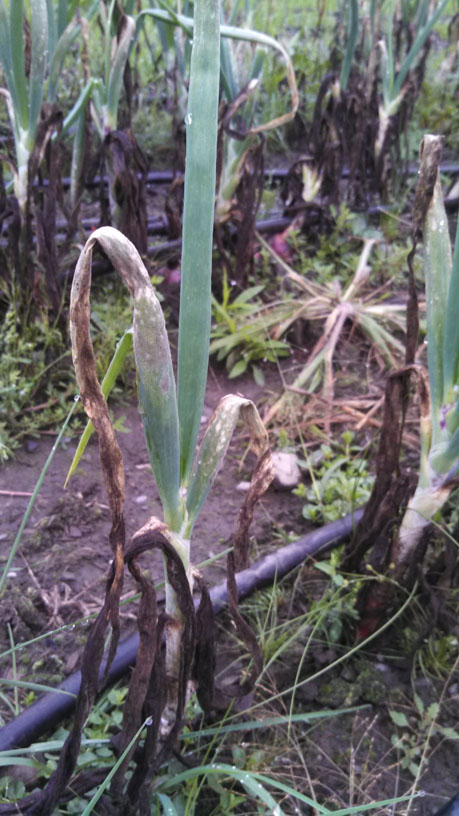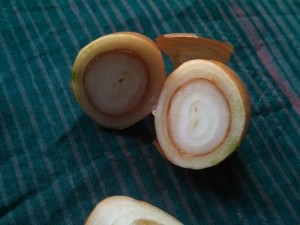 If you talk to farmers from across the agricultural disciplines – organic farmers, conventional farmers, permaculturists, homesteaders – one thing you’ll hear repeated is the observation that in each growing season certain crops exceed all expectations with prolific growth and yields while others fall short of the mark. In 2013, as some of you know, the onions at Green Mountain Girls Farm sadly fell into the latter catagory. One of the biggest factors for what amounted to a loss of most of our onions (at least 2/3 of the plants never got taller than a couple inches) was probably the exceedingly wet weather we experienced for much of the early part of last summer.
If you talk to farmers from across the agricultural disciplines – organic farmers, conventional farmers, permaculturists, homesteaders – one thing you’ll hear repeated is the observation that in each growing season certain crops exceed all expectations with prolific growth and yields while others fall short of the mark. In 2013, as some of you know, the onions at Green Mountain Girls Farm sadly fell into the latter catagory. One of the biggest factors for what amounted to a loss of most of our onions (at least 2/3 of the plants never got taller than a couple inches) was probably the exceedingly wet weather we experienced for much of the early part of last summer.
In the fall, when we discovered we had enough onions for our members and retail shoppers for just a fraction of the winter, we decided to buy in onions from another farm whose values and practices we thought meshed well with our own. Though something of an untested approach, we hoped that at least it would provide you with the all-important onion (what recipe dosn’t have onions in it!) until the spring. Unfortunately, as we have realized, we were not the only farm to experience the challenging wet weather of 2013. Many growers in Vermont and other parts of New England suffered major losses of their allium crops, including the farm that provided us with our back-up store of onions.
 Only a few cold, snowy days passed before we noticed that a large number of our guest onions had softer-than-usual tops. From the outside the onions looked mostly fine so, being good crop detectives, we had only one choice: to start cutting open the soft-topped bulbs and find out what was going on inside. We found that almost half the onions with soft tops where completely fine, while the other half had soft rot: perfectly fine outside layers but a rotten inside layer, an issue that takes hold while the plants are still growing in the field and one that is often associated with periods of extended wet weather. The hardest part about soft rot is that it seems almost impossible to tell if a bulb has it until you cut it open! With the help of our student guests from Williams College a couple weeks ago, we pulled all the onions we could find with soft tops (almost 150 pounds). Then, with our tear-preventing onion-goggles strapped to our heads, we spent an afternoon peeling, chopping, bagging and freezing onions. For now, there are still onions for sale at our farm stand, some of ours, those that survived are storing well, and a few from another farm. Watch out for soft tops, feel free to cut a bulb open in the name of science, know we are happy to replace any soft ones you did purchase and be on the lookout for some fantastic oniony dishes coming out of the Green Mountain Girls Farm kitchen!
Only a few cold, snowy days passed before we noticed that a large number of our guest onions had softer-than-usual tops. From the outside the onions looked mostly fine so, being good crop detectives, we had only one choice: to start cutting open the soft-topped bulbs and find out what was going on inside. We found that almost half the onions with soft tops where completely fine, while the other half had soft rot: perfectly fine outside layers but a rotten inside layer, an issue that takes hold while the plants are still growing in the field and one that is often associated with periods of extended wet weather. The hardest part about soft rot is that it seems almost impossible to tell if a bulb has it until you cut it open! With the help of our student guests from Williams College a couple weeks ago, we pulled all the onions we could find with soft tops (almost 150 pounds). Then, with our tear-preventing onion-goggles strapped to our heads, we spent an afternoon peeling, chopping, bagging and freezing onions. For now, there are still onions for sale at our farm stand, some of ours, those that survived are storing well, and a few from another farm. Watch out for soft tops, feel free to cut a bulb open in the name of science, know we are happy to replace any soft ones you did purchase and be on the lookout for some fantastic oniony dishes coming out of the Green Mountain Girls Farm kitchen!